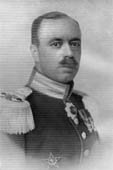 “I still remember the scabrous expression on Talat’s face,
“I still remember the scabrous expression on Talat’s face,
when he said that the Armenian issue was resolved”
Einar af Wirsén was born in 1875, in Uppsala, Sweden. He received his higher military education at the Royal Military Academy of Sweden. In 1900-1902, he has entered the Swedish Royal Army Staff College. In 1903, he has received the degree of attachment and continued his education. During 1910-1914 he has served in the General Staff. In August 1915, he was sent to the Ottoman Empire for diplomatic service. As a military attaché to the Swedish embassy, he remained in the empire until 1920, first in Constantinople, then in Sofia. As a diplomatic representative of a neutral country, Wirsén had the opportunity to travel through the empire during the war, to go to the front, to meet Turkish-German military and political figures. Wirsén’s information on the Armenian Genocide is based on the diplomat’s personal observations, German-Turkish military intelligence, as well as unofficial testimonies provided by German military personnel in the Ottoman Empire. Wirsén’s first telegrams to the Stockholm General Staff about the Armenian Genocide date back to February 1916. The attaché emphasizes that the deportation of Armenians is not the result of the governmental miscalculation or inability to control the situation, but is aimed at their destruction. Wirsén speaks of the unfriendly attitude of Turkish circles towards him due to a booklet in 1919 on the Balkans, in which he spoke negatively about the political order.
Wirsén spoke in detail about the history of the Armenian Genocide in his memoir of the war
“Memories of War and Peace” (Minnen från fred och krig), which was published in Stockholm, in 1942. The chapter of the book entitled
“Murder of a Nation” is entirely dedicated to the organized nature of the extermination of Armenians in the Ottoman Empire, the methods of murder:
“The displaced were often classified into groups; Men were kept separate from women and children. Men were being killed in masse, young women were sent to Turkish harems. Children were left to starve, as was the case in several states. The children were tied up to each other in hundred groups thrown on rafts, and drowned in the Euphrates”. He also states that the destruction orders were issued secretly and orally. According to Wirsén, about one million Armenians were killed in the empire as a result of government measures.
During 1920-1940, Einar af Wirsén continued his diplomatic service in various countries. His work within the circle of League of Nations was an important episode in his career. In 1924-1925, Wirsén has been appointed as a member of the League of Nations Commission of Inquiry into Mosul. His report had a decisive role in the decision of the Council of the League of handing over Mosul to Iraq. Wirsén died in January 1946, in Sweden.
Regina Galustyan
AGMI applicant, researcher
1. Einar af Wirsén, Minnen från fred och Krig (Stockholm: A. Bonnier, 1942).
2. Vahagn Avedian, “Knowing and Doing: the Armenian Genocide in Official Swedish Reports” in In Times of Genocide 1915-2015: Report from a Conference on the Armenian Genocide and Syriac Seyfo, ed. Lars Hillås Lingius (Stockholm: Bilda Förlag, 2015), pp. 71-83.





